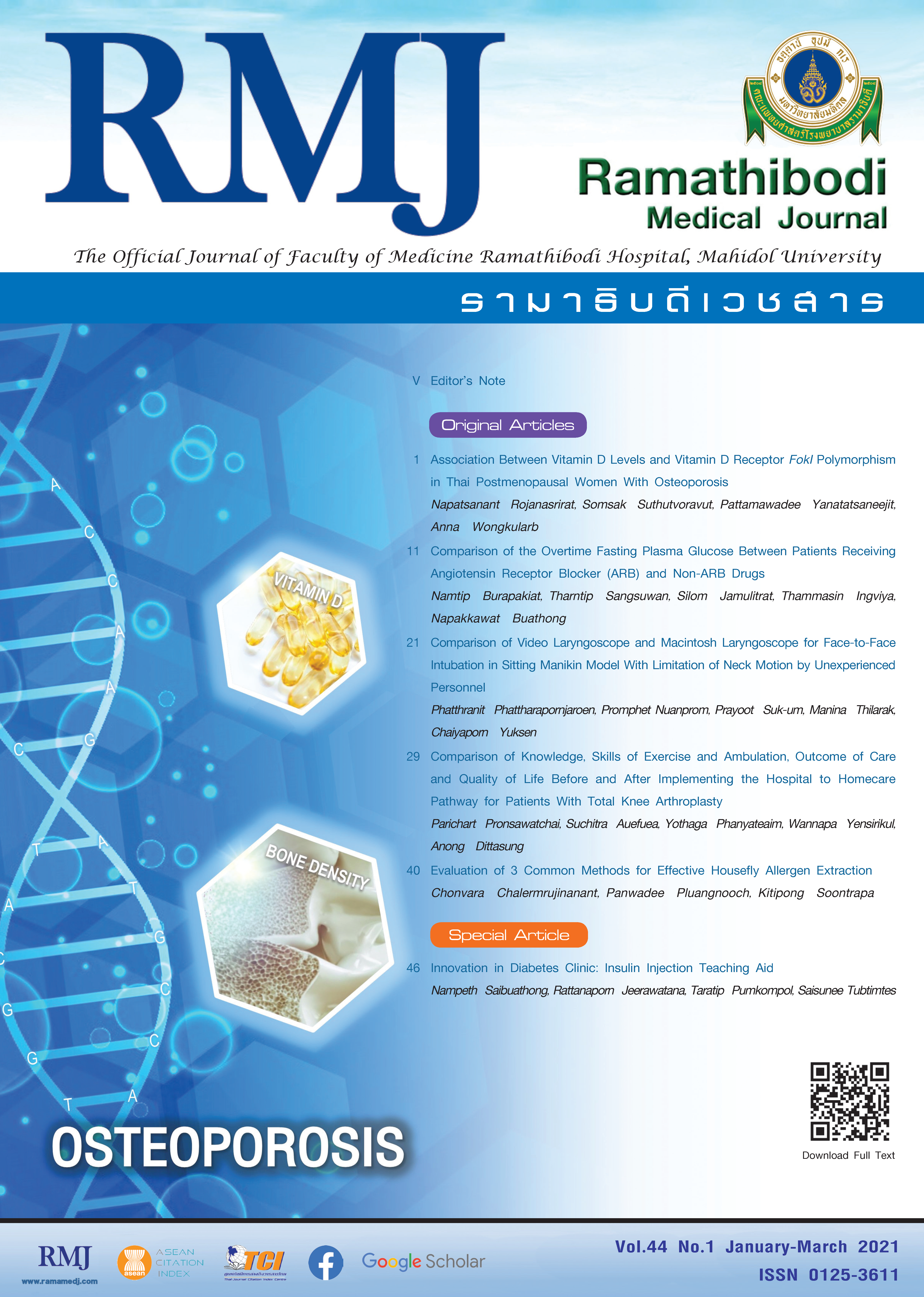Comparison of the Overtime Fasting Plasma Glucose Between Patients Receiving Angiotensin Receptor Blocker (ARB) and Non-ARB Drugs
DOI:
https://doi.org/10.33165/rmj.2021.44.1.245230Keywords:
Angiotensin receptor blocker, Fasting plasma glucose, HypertensionAbstract
Background: Previous studies have shown a relationship between renin angiotensin aldosterone system (RAAS) and insulin resistance. This in turn can delay the onset of diabetes mellitus (DM). The impact of angiotensin receptor blocker (ARB) on the fasting plasma glucose (FPG) level is not clear.
Objective: To compare the overtime FPG between ARB and non-ARB using.
Methods: A retrospective-longitudinal cohort study, data were collected from medical records of hypertensive patients who were not diagnosed DM in 2007 and 2008, each patient was followed up 10 years. The association between antihypertensive drugs and FPG by multilevel mixed-effects linear regression was evaluated. Multistate Markov chain model was used to evaluate the probability to become pre-DM or DM stage.
Results: Of 822 patients, 571 patients were excluded and 251 patients met criteria for analysis. From multilevel mixed-effects linear regression, ARB usage was associated with a nonsignificant decreased FPG when adjusted with visit (mean FPG change, -0.98; 95% CI, -2.65 to 0.69; P = .25) and with visit plus glomerular filtration rate (mean FPG change, -1.89, 95% CI, -4.88 to 1.19; P = .24). The probability of change in 10 years from normal to pre-DM stage was 0.41 and 0.38, normal to DM stage was 0.03 and 0.01, pre-DM to DM stage was 0.08 and 0.04, in non-ARB and ARB group, respectively.
Conclusions: ARB tended to decrease probability to become DM. Thus, physicians should prescribe ARB in hypertensive patients to prevent new-onset DM.
References
Aekplakorn W, Pakcharoen H, Thaikla K, Satheannoppakao W. Thai National Health Examination Survey V, 2014. Nonthaburi: Health Systems Research Institute; 2016. Accessed September 9, 2020. https://www.hiso.or.th/hiso/picture/reportHealth/report/report9.pdf
Ministry of Public Health, Department of Disease Control. Theme of world diabetes day - 2016. Division of Non Communicable Diseases website. Published October 21, 2016. Accessed September 9, 2020. http://www.thaincd.com/2016/news/hot-news-detail.php?id=12305&gid=18
Chatterjee S, Riewpaiboon A, Piyauthakit P, et al. Cost of diabetes and its complications in Thailand: a complete picture of economic burden: cost of diabetes from a societal perspective in Thailand. Health Soc Care Community. 2011;19(3):289-298. doi:10.1111/j.1365-2524.2010.00981.x
Diabetes Association of Thailand under the Patronage of Her Royal Highness Princess Maha Chakri Sirindhorn. Clinical Practice Guideline for Diabetes 2017. Romyen Media; 2017. Accessed September 9, 2020. https://www.dmthai.org/attachments/article/443/25610702_guideline-diabetes-care-2017.pdf
Li Z, Li Y, Liu Y, Xu W, Wang Q. Comparative risk of new-onset diabetes mellitus for antihypertensive drugs: a network meta-analysis. J Clin Hypertens, (Greenwich). 2017;19(12):1348-1356. doi:10.1111/jch.13108
Abuissa H, Jones PG, Marso SP, O'Keefe JH Jr. Angiotensin-converting enzyme inhibitors or angiotensin receptor blockers for prevention of type 2 diabetes: a meta-analysis of randomized clinical trials. J Am Coll Cardiol. 2005;46(5):821-826. doi:10.1016/j.jacc.2005.05.051
Al-Mallah M, Khawaja O, Sinno M, Alzohaili O, Samra AB. Do angiotensin converting enzyme inhibitors or angiotensin receptor blockers prevent diabetes mellitus? a meta-analysis. Cardiol J. 2010;17(5):448-456.
Krachanglikhit N, Jamulitrat S, Sangsuwan T. Antihypertensive Drug Classes And New Onset of Type 2 Diabetes Mellitus in Primary Care Setting. Faculty of Medicine, Prince of Songkla University; 2017:50.
Hu FB, Meigs JB, Li TY, Rifai N, Manson JE. Inflammatory markers and risk of developing type 2 diabetes in women. Diabetes. 2004;53(3):693-700. doi:10.2337/diabetes.53.3.693
Duncan BB, Schmidt MI, Offenbacher S, Wu KK, Savage PJ, Heiss G. Factor VIII and other hemostasis variables are related to incident diabetes in adults. The Atherosclerosis Risk in Communities (ARIC) Study. Diabetes Care. 1999;22(5):767-772. doi:10.2337/diacare.22.5.767
Tsikouris JP, Cox CD. Pharmacologic blockade of the renin-angiotensin system: vascular benefits beyond commonly understood pharmacologic actions. Pharmacotherapy. 2003;23(9):1141-1152. doi:10.1592/phco.23.10.1141.32763
Ferri C, Bellini C, Desideri G, et al. Relationship between insulin resistance and nonmodulating hypertension: linkage of metabolic abnormalities and cardiovascular risk. Diabetes. 1999;48(8):1623-1630. doi:10.2337/diabetes.48.8.1623
Sanchez R, Fischer P, Cuniberti L, Masnatta LD, Ramírez AJ. Vascular oxidative stress is associated with insulin resistance in hyper-reninemic nonmodulating essential hypertension. J Hypertens. 2007;25(12):2434-2440. doi:10.1097/HJH.0b013e3282f03597
Aziz H, Hatah E, Makmor Bakry M, Islahudin F. How payment scheme affects patients’ adherence to medications? a systematic review. Patient Prefer Adherence. 2016;10:837-850. doi:10.2147/PPA.S103057
Mitrakou A. Kidney: its impact on glucose homeostasis and hormonal regulation. Diabetes Res Clin Pract. 2011;93 Suppl 1:S66-S72. doi:10.1016/S0168-8227(11)70016-X
Paolisso G, Sgambato S, De Riu S, et al. Simvastatin reduces plasma lipid levels and improves insulin action in elderly, non-insulin dependent diabetics. Eur J Clin Pharmacol. 1991;40(1):27-31. doi:10.1007/BF00315135

















